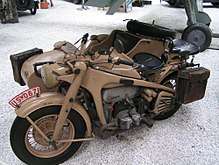Zündapp KS 750

The Zündapp KS 750 is a World War II-era motorcycle and sidecar combination developed for the German Armed Forces during the Second World War by the German company Zündapp G.m.b.H. . Based on an ingenious rigid frame design and incorporating many unique and refined features, after entering service in 1941 this sophisticated motorcycle served on all the major German battlefronts, and thanks to its versatility and ruggedness it was extensively used in a variety of roles.
Development
At the end of 1937 the Oberkommando des Heeres requested the development of a bike with the following criteria:
- A payload of 500 kg, corresponding to three fully equipped soldiers.
- A fully loaded permanent speed of 80 Km/h on the Autobahn and 95 Km/h maximum speed. The minimum speed had to be 4 Km/h to accompany marching troops.
- 4,5 x 16" cross country tyres should be used.
- A minimum ground clearance of 150 mm and enough clearance under the mudguards in order to use snow chains.
- A substantial offroad capability, including fording shallow waters and climbing steep inclines.
Up until then all motorcycles used by the military derived from civilian models, but the need for a fast moving army - part of the modern vision behind the German Armed Forces restructuring - meant that no money should be spared for the creation of a motorcycle and sidecar combination that was supposed to be extremely versatile, performing and dependable. All of this came at a cost of course, and although it was clear that no money had to be spared for these motorcycles, it is believed that by the end of 1944 it was realised that two Volkswagen Kübelwagen could be built for the same cost of one Zündapp KS 750, therefore production of the latter was discontinued.
Initially Zündapp considered modifying their KS 600 model in order to meet the OKH demands, but it was soon clear that the KS 600 was not suitable for further development: the frame, engine, transmission, front fork and many other parts would have to be either reinforced or receive substantial modifications to meet the new criteria. Eventually Zündapp came to the conclusion that what they needed was a new, purpose-built motorcycle and sidecar. By 1939 they had developed two prototypes, which the OKH used for test drives. In both bikes the cubic capacity was increased to 700 cc and the cylinders were lifted on each side by 5° to increase ground clearance. Subsequently the cubic capacity was further increased to 751 cc.
The call for the new motorcycle was also responded by BMW, which produced their prototype of the BMW R75. After long test drives both with the BMW and Zündapp prototypes the OKH was convinced that the Zündapp KS 750 was far superior to the BMW R75. Initially BMW was asked to built the Zündapp KS 750 under licence, but understandably BMW refused. However, the OKH asked BMW to adopt the superior characteristics of the Zündapp KS 750, such as the rear wheel drive solution, the hydraulic brake system and wheels. BMW and Zündapp also agreed - as demanded by the OKH - a standardisation of as many components as possible in order to streamline production and delivery of spare parts, which would then be usable and interchangeable on both models.
Development continued until 1940, eventually seven bikes were used for longer test drives and to refine the last details. On April 1940 the OKH confirmed full acceptance of the Zündapp KS 750, and despite the satisfaction with the early production models, improvements were included regularly throughout production.
The series production started in Spring 1941, and in 8 years Zündapp produced 18.695 KS 750 in their Nuremberg factory. Whilst military production ground to a halt in early 1945, a small batch was produced starting from 1946 both for the Finnish Army and civilian market.
| Production Year | Units Produced | Serial Numbers |
|---|---|---|
| 1939 | 2 | pre-series, no serial number |
| 1940 | 7 | 600 000 - 600 006 |
| 1941 | 288 | 600 007 - 600 295 |
| 1942 | 7.228 | 600 296 - 607 523 |
| 1943 | 7.131 | 607 524 - 614 654 |
| 1944 | 3.515 | 614 655 - 618 169 |
| 1945 | 115 | 618 170 - 618 284 |
| 1946 | 205 | 620 001 - N/A |
| 1947 | 76 | N/A |
| 1948 | 68 | N/A - 620 349 |